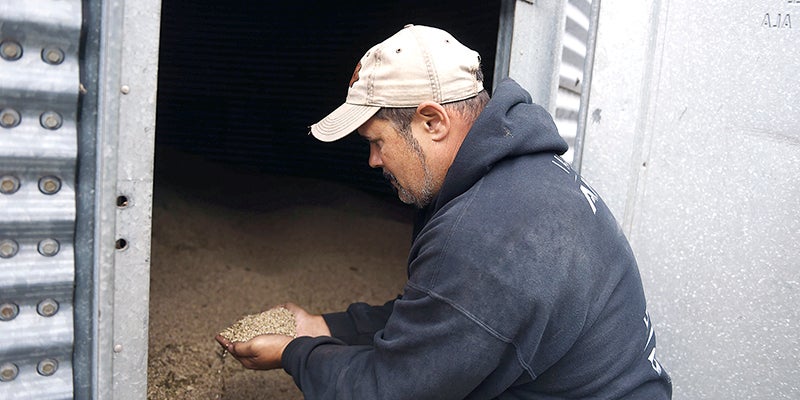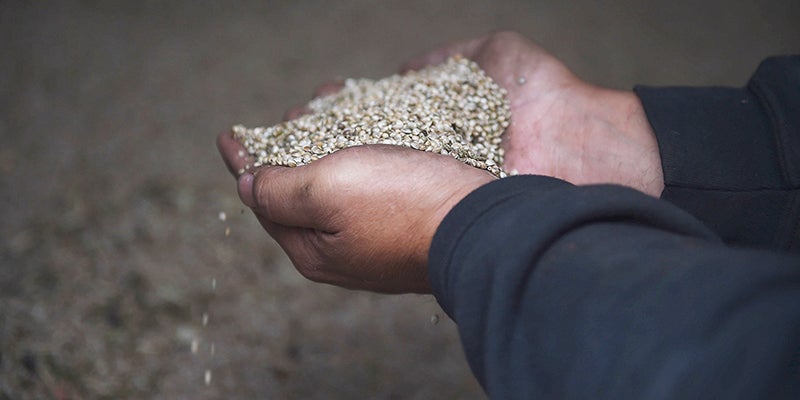Diversity in agriculture
Published 8:21 pm Friday, October 22, 2021

- Tom Cotter reaches in for a handful of hemp seeds Thursday afternoon. Cotter planted 50 acres of industrial hemp this year in a move he hope will help environmentally. Photos by Eric Johnson/photodesk@austindailyherald.com
|
Getting your Trinity Audio player ready...
|
Local farm continues growth through hemp
For a number of years now, local farmer Tom Cotter has been on the forefront of sustainable farming methods that are environmentally friendly. He’s also gone with two others in the area — Jeff Brinkman and Marty Tebay — in bringing Superior Cannabis to life in Austin off their own growth of hemp for CBD oils.
Now Cotter is experimenting anew, this time on the industrial hemp side of things. This past season, Cotter devoted 50 acres of land to growing hemp in an effort not only to tap into a plant that is proven to be environmentally friendly, but also has an array of benefits from being included in plastics, rope and synthetic oils.
“If you’re going to change the world, if we’re going to help fight climate change, I think this is the way to go,” Cotter said from his farm Wednesday afternoon.
Hemp is largely underutilized in the United States, in large part because of the mistaken comparison to the marijuana plant, which is in the same family. However, hemp does not have the same qualities of marijuana and is not a recreational drug.
Nevertheless, because of the association, hemp was at one point prohibited from being grown by farmers, despite the good the plant does and its many uses.
For starters, it’s incredibly weed resistant.
“I watch those plants that’s out-competing any weeds out there,” Cotter said. “If we can reduce chemicals in the countryside, that’s a win-win.”
Many of Cotter’s crops are grown organically, eliminating the need for pesticides and herbicides, which can often leak into groundwater.
The hardy plant has shown to be able to cope with selenium, which occurs naturally in the soil, and according to a 2018 Rolling Stone article, scientists planted hemp in fields surrounding Chernobyl in the 1990s, the site of the 1986 nuclear plant melt down.
It was shown that the plant could filter out harmful contaminants —including heavy metals such as lead, cadmium and nickel — from the soil.
This finding was confirmed by German researchers in 2001.
While these kinds of ground contaminants are not usually found in our area, there is a use for the potential to filter other things out of the soil and the air.
“Hemp is one of the best plants at capturing carbon,” Cotter said. “There are just so many assets to that plant, it’s amazing.”
While admitting he has researched hemp and the soil himself, SWCD soil scientist Steve Lawler said that the introduction of hemp into the planting rotation helps just on diversity alone.
“What encourages us is that hemp is a different crop,” Lawler said. “We really encourage folks to be looking at other markets. It alters the biological sense of the soil. From the standpoint of crop diversity, it’s great.”
Lawler has worked with Cotter in the past, including Cotter’s introduction of cover crops, sparing a piece of land for a year and letting it rejuvenate.
It’s these kinds of things — using cover crops, growing diversely and growing organic — that allows an environment-first approach.
“When you only have a cash crop, then you kind of leave yourself open and your only defense is chemical,” Lawler said. “If there’s a blip in the technology or that technology wears down, then nature will eventually get around that and we’re back to what farmers used for eons — diversity.”
However, the hurdle remains misconceptions of the plant. The last major crop of hemp in the United States was in the 1930s, before laws were enacted against all forms of hemp with the fear that they were all similar to the effects brought on by marijuana.
Only in recent years has there been somewhat of a return to the growing and use of hemp. Cotter said that the defense against misconceptions is education.
“Until people educate themselves, they just think they can’t do that,” Cotter said.
In Cotter’s case, he is largely growing the plant for the seeds, in which there are several health benefits, including a source of protein and Omega-3 fatty acids.
Another problem, though, is the expense involved. There are very few plants in the state of Minnesota that can process the plant. Cotter needs to bring his harvested plants to Hemp Acres near Waconia — a two-hour, one-way trip.
Once facilities become more common, the expensive cost of growing hemp is bound to go down.
“We just need facilities out there,” Cotter said, while also saying that growth will depend on the medical marijuana industry. “Even though that’s not what I’m growing, the more that breaks through, the more that will help this.”
In the meantime, Cotter will continue experimenting, with plans to grow his acres devoted to hemp from 50 to around 80 to a 100 acres next year, and it will walk hand-in-hand with improving the environment.
“There’s a time where chemicals are needed and it does work for us,” Cotter said. “But in the long run we want to make sure we’re better for our environment. The hemp is really exciting. It’s great stuff.”




